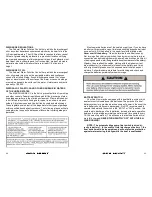
24
TOWING OR BEING TOWED
In the event of a mishap or power loss you may need to tow a
boat or have yours towed. Remember you should not tow a boat lar-
ger than your own. Never tow a boat if you are not equipped with the
proper lines. Nylon ropes are recommended. They have the strength
and elasticity needed to absorb the shock of towing and sudden jerks.
Individuals should never hold a towline; always secure it to the boat.
Before towing a boat, make a bridle and tie it securely to the
stern eyes on the transom with enough slack to clear the engines.
Pad the line wherever it comes into contact with the boat to prevent
chafing. Attach a tow line to the bridle so that it can slide from side to
side to prevent too much pressure on a single stern eye. The tow line
should then be attached to the bow eye or to a bridle on the towed
boat. The tow line should be a minimum of twice the length of the
towing boat, the longer the better. When passing the tow line to the
other boat do not try to run in too close. Send either a light line or
attach the towline to a life preserver to be pulled in. Beware of each
boat’s propeller.
The towed boat should always have someone at the wheel since the
boat may swing off course. Start the tow off slowly. A steady pull at a
moderate speed should be used. It is important to keep the slack out
of the propeller area. Watch the action of the towing boat. If exces-
sive slack develops in the towline and contact is obvious turn in either
direction to avoid hitting the stern. As a precaution passengers on
both boats should stay clear of the tow line. Lines under stress could
snap and fly in either direction causing injury.
SHALLOW WATER
Most boats that become grounded can be floated off with motors
tilted to reduce the draft at the transom. Do not attempt to power off if
the propellers are in mud or sand due to possible damage to your
engine’s cooling system.
41
If an awning or boat cover is suitable in size for a washing ma-
chine, these steps should be followed:
Use only mild soaps. No detergent.
Wash and rinse in cold water.
Air dry. Never put Sunbrella fabrics in your dryer.
Re-treating the Fabric
As part of the finishing process, Sunbrella fabrics are treated
with a fluorocarbon finish, which enhances water repellency. This
finish is designed to last for several years, but must be replenished
after a thorough cleaning. Based on test results, Glen Raven rec-
ommends 303 High Tech Fabric Guard™ as the preferred re-
treatment product for Sunbrella fabrics. Fabrics should be retreated
after thorough cleaning or after five years of use. Check with your
local Sunbrella dealer or distributor for more information.
Applying 303 High Tech Fabric Guard™
303 should be applied to Sunbrella fabrics after each thorough
cleaning, which typically removes the original fluorocarbon finish
and reduces the fabric’s water repellency. After cleaning the fabric,
allow it to air dry completely and then apply 303 in a thin, even
coat. After allowing the first coat of 303 to air dry, apply a second
thin, even coating of 303. Two light coatings are more effective in
restoring fabric water resistance than a single heavy coating. A 15-
ounce bottle provides coverage of up to 50 square feet of light-
weight fabric. Always apply 303 to clean fabric.
ZIPPERS & SNAPS
Zippers and snaps will loosen with use. Use care when starting
the zipper to prevent damage. Lubricate the snap buttons and zip-
pers with petroleum jelly or paraffin. Fasteners should be unsnapped
as close to the button as possible.
Apseal® is a registered trademark of Astrup. UnisealTM is a
trademark of Unitex. Scotchguard® is a registered trademark of 3M.
VINYL
Clean clear vinyl thoroughly with denatured alcohol and then ap-
ply a protective layer of clear wax. Do not use paste wax – it will turn
the vinyl yellow. This process should be repeated as necessary to
maintain the protective wax coating.
Store and secure canvas before trailering.
Dry all canvas before storing to prevent mildew.
Remove the top, front and side panels; roll them up for storage.
This procedure is necessary to prevent the front and side vinyl
pieces from cracking. NEVER FOLD THESE PIECES!









































